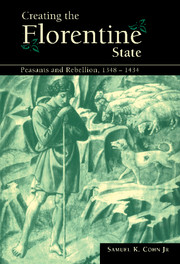Book contents
- Frontmatter
- Contents
- List of illustrations
- List of tables
- Acknowledgements
- Note on citations, dates, and measures
- Introduction
- PART I CULTURE, DEMOGRAPHY, AND FISCALITY
- PART II PEASANT PROTEST IN THE MOUNTAINS: THREE VIEWS
- PART III GOVERNMENTAL CLEMENCY AND THE HINTERLAND
- 7 Florentine peasant petitions: an institutional perspective
- 8 The reasons for assistance
- 9 What the peasants won
- Conclusion
- Appendix 1 Regression models: wealth, migration, and taxes
- Appendix 2 Tax coefficients, 1354–1423
- Bibliography
- Index
7 - Florentine peasant petitions: an institutional perspective
Published online by Cambridge University Press: 07 August 2009
- Frontmatter
- Contents
- List of illustrations
- List of tables
- Acknowledgements
- Note on citations, dates, and measures
- Introduction
- PART I CULTURE, DEMOGRAPHY, AND FISCALITY
- PART II PEASANT PROTEST IN THE MOUNTAINS: THREE VIEWS
- PART III GOVERNMENTAL CLEMENCY AND THE HINTERLAND
- 7 Florentine peasant petitions: an institutional perspective
- 8 The reasons for assistance
- 9 What the peasants won
- Conclusion
- Appendix 1 Regression models: wealth, migration, and taxes
- Appendix 2 Tax coefficients, 1354–1423
- Bibliography
- Index
Summary
Recent studies on peasant revolts in Italy have challenged an earlier historiography, claiming that even those in Angevin Sicily were not “true” peasant revolts and for others “a concept of ‘class struggle’ can be applied only with great strain.” While the participants carefully systematized the range of peasant acts of violence over the central and later Middle Ages, they failed to clarify exactly what would constitute “true and proper ‘insurrections’” as opposed to what one has called “small-change criminality.” One criterion used by historians to deny that certain peasant uprisings constituted “true” rebellion is the supposed absence of any long-term consequences. Such a yardstick has been brought to bear on insurrectionary activity even as widespread as the fourteenth-century Jacquerie or the English Uprising of 1381 – the usual benchmark of a “true” peasant revolt of the later Middle Ages. For the English Uprising the debate goes on about just how profound or long-lasting were its effects on English government and serfdom.
Following the definitions of rebellion used by contemporaries in chronicles, criminal records, and the government decrees, this study has defined a peasant revolt simply as an attempt staffed primarily by villagers, most of whom tilled the soil, to wrest castles or other territory from their feudal lords or the Republic of Florence, regardless of the leadership or the outcome.
- Type
- Chapter
- Information
- Creating the Florentine StatePeasants and Rebellion, 1348–1434, pp. 197 - 209Publisher: Cambridge University PressPrint publication year: 1999



